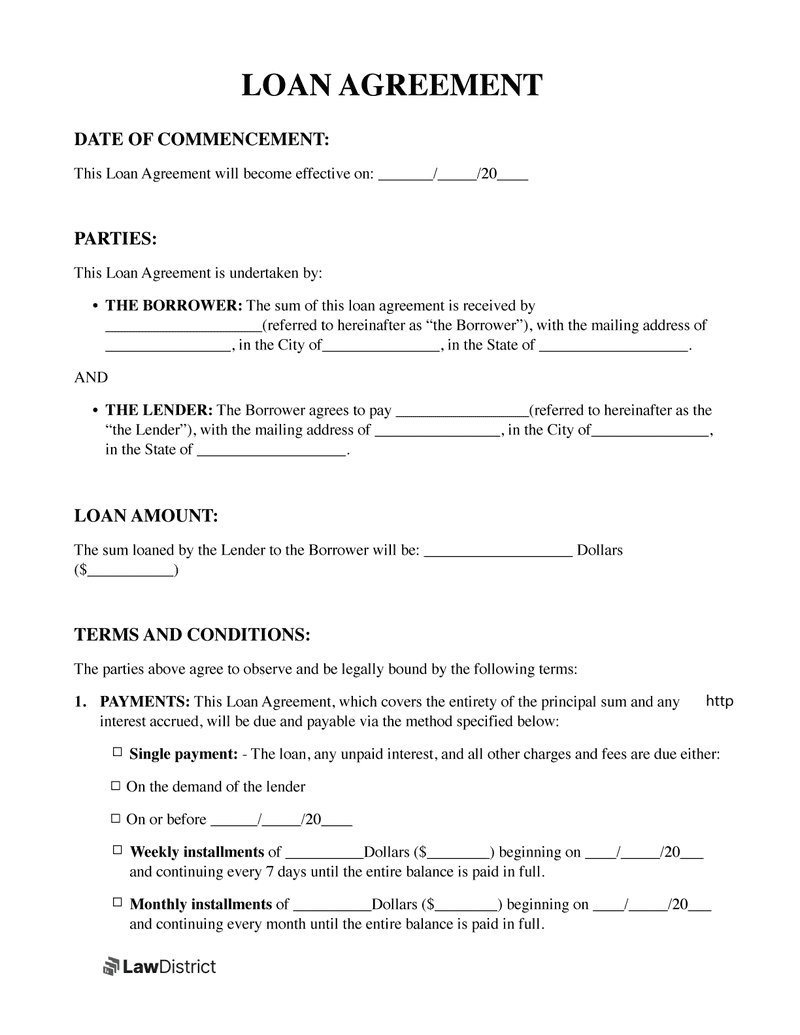THIS LOAN AGREEMENT (this "Agreement") is
dated this ________ day of ________________, ________, and made
BETWEEN:
_________ of _________
(the "Lender")
OF THE FIRST PARTY
AND
_________ of _________
(the "Borrower")
OF THE SECOND PARTY
IN CONSIDERATION OF the Borrower obtaining a Loan (the "Loan") from the Lender and the Borrower repaying such Loan to the Lender, the parties agree to support, execute and satisfy the promises and conditions written in this Loan Agreement:
1. The Borrower desires to obtain a Loan (the "Loan") from the Lender in the original principal amount of $_________ USD. The Borrower promises to repay this amount to the Lender, without interest payable on the unpaid amount, beginning on _________.
2. Full repayment of the Loan shall be required by _________.
3. Lump sum payments are allowed under this Loan Agreement if and only if the Borrower does not default on the Borrower's obligations. The Borrower may make lump sum payments to the principal amount or pay any outstanding amount owed under this Loan Agreement without having to pay penalties to the Lender for making such lump sum payments.
4. Unless this Loan Agreement states otherwise, if the Borrower fails to provide payment as agreed upon in this Loan Agreement, then the Lender may declare the principal amount owed to be immediately due and payable at that time.
5. This Loan Agreement will be interpreted, construed, and governed under the laws of the .
6. The Borrower shall assume all liability regarding costs, expenses, and expenditures incurred, including the legal costs, by the Lender to enforce the obligations in the Loan following any default by the Borrower. Further, such costs shall be added to the outstanding principal and shall be due and paid by the Borrower immediately following the demand of the Lender.
7. This Loan Agreement will enure to the benefit and be binding upon the respective heirs, executors, administrators, successors, and authorized assigns of the Borrower and the Lender. The Borrower waives the presentation of payment, notice of non-payment, protest, and notice of protest.
8. This Loan Agreement may only be amended or modified through a written agreement executed by the Borrower and the Lender.
9. If any provision under this Loan Agreement is held as invalid or unenforceable by a court with jurisdiction over this matter, such provision shall be rendered as enforceable by the court to the extent that it may be legally possible. All remaining provisions under this Loan Agreement shall not be affected.
IN WITNESS WHEREOF, the parties have duly signed this ________ day of ________________, ________
SIGNED, SEALED, AND DELIVERED
this ________ day of ________________, ________.
| | |
_______________________________
_________
|
| | | | |
SIGNED, SEALED, AND DELIVERED
this ________ day of ________________, ________.
| | |
_______________________________
_________
|
| | | | |

